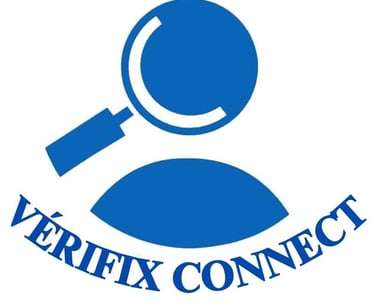What is ATS Tracker ?
You’ve learned about ATS – now put that knowledge into action! Explore more of our job search tips and insights, or reach out directly for personalized support on your career journey.
7/24/20256 min read
Vérifix Connect: Your Path to Career Success
Navigating today’s job market can be tough, but it doesn’t have to be. At Vérifix Connect, we empower job seekers like you with the knowledge, tools, and insights needed to stand out. From mastering Applicant Tracking Systems (ATS) to crafting compelling applications, we’re here to bridge the gap between you and your dream job. Explore our resources and connect with opportunities that truly fit.




What is an Applicant Tracking System (ATS)?
And Why Does it Matter for Your Job Search?
In today’s competitive job market, landing your dream role often feels like navigating a complex maze. You spend hours perfecting your resume, crafting a compelling cover letter, and then hit “submit” – only to wonder if your application ever truly sees the light of day. If this sounds familiar, it’s highly likely your application just met an Applicant Tracking System, or ATS.
At Vérifix Connect, we understand the intricacies of the hiring process. That’s why we’re breaking down what an ATS is, how it works, and most importantly, why understanding it is crucial for your job search success.
So, What Exactly is an ATS?
An Applicant Tracking System (ATS) is a software application that helps companies manage their recruitment and hiring processes. Think of it as a digital HR assistant that streamlines everything from job posting to onboarding. While the primary goal for companies is to handle a high volume of applications efficiently, for job seekers, it’s the gatekeeper to an interview.
Here’s a simplified look at what an ATS does:
Collects Applications: When you apply online, your resume and cover letter are uploaded directly into the ATS database.
Parses and Organizes Data: The ATS then “reads” and extracts key information from your documents, categorizing it into structured fields (e.g., work experience, education, skills).
Screens and Ranks Candidates: This is where it gets critical for job seekers. The ATS uses algorithms to compare your application against the job description. It looks for keywords, phrases, and specific qualifications that match the employer’s requirements. Based on these matches, it scores or ranks candidates.
Facilitates Collaboration: Recruiters and hiring managers can use the ATS to review applications, make notes, schedule interviews, and communicate with candidates – all within the same system.
Why Do Companies Use an ATS?
The benefits for companies are clear:
Efficiency: Automates tedious manual tasks, saving HR teams valuable time.
Organization: Keeps all applicant data in one centralized, searchable location.
Consistency: Standardizes the application review process.
Scalability: Allows companies to handle a large volume of applications without being overwhelmed.
Compliance: Helps ensure fair hiring practices and compliance with regulations.
Why Should You Care About the ATS?
As a job seeker, the ATS is your first, and often most challenging, hurdle. If your application isn’t optimized for an ATS, it might never reach the eyes of a human recruiter, regardless of how qualified you are.
Here’s why it matters for you:
Keyword Matching is Key: The ATS primarily relies on keywords. If your resume doesn’t contain the specific terms and phrases used in the job description, it’s less likely to be flagged as a match.
Formatting Matters (Less is More!): While visually appealing resumes are great for human eyes, complex formatting (fancy fonts, elaborate graphics, tables, text boxes) can confuse an ATS, leading to misinterpretation or incomplete parsing of your data.
The “Invisible” Filter: Many qualified candidates are overlooked not because they lack skills, but because their applications aren’t ATS-friendly.
Vérifix Connect’s Tip for ATS Success:
At Vérifix Connect, we emphasize the importance of tailoring your application. This isn’t just about changing a few words; it’s about strategically aligning your resume and cover letter with the language of the job description.
Before you hit “apply,” consider:
Mirror the Language: Use the exact keywords and phrases from the job posting in your resume and cover letter.
Standard Formatting: Opt for clean, simple resume templates. Use standard headings and bullet points. Avoid excessive graphics or intricate layouts.
Quantify Your Achievements: While ATS might not “understand” impact, using numbers and metrics strengthens your resume for when a human does review it.
Understanding the ATS isn’t about “tricking” the system; it’s about ensuring your qualifications are accurately recognized and presented. By making your application ATS-friendly, you significantly increase your chances of moving past the initial screening and getting your resume into the hands of a hiring manager.
Stay tuned to the Vérifix Connect blog for more insights and tips to supercharge your job search!
” Work Smarter, Not Just Harder in Your Job Search. "
Applicant Tracking Systems are the gatekeepers for many top companies. Learn the key strategies to tailor your resume and speak the ATS language, increasing your visibility to recruiters.

Frequently asked questions
This powerful quote reminds us of the resume’s true purpose: to open the door. In today’s digital age, that door is often guarded by an Applicant Tracking System (ATS). Understanding the ATS isn’t about outsmarting a machine; it’s about ensuring your skills and experiences are clearly communicated in a language the system understands. By optimizing your resume, you’re not just improving your chances with the ATS, you’re investing in the opportunity to showcase your full potential directly to a hiring manager, moving one crucial step closer to securing that dream role.
Can I “trick” an ATS?
The goal isn’t to trick the ATS, but to optimize your resume so it accurately reflects your qualifications in a way the ATS can understand. Techniques like “keyword stuffing” (listing a bunch of keywords in white font) are ineffective and can even get your application flagged negatively if discovered. Focus on genuine alignment with the job description.
Why do companies use an ATS?
Companies use ATS for several reasons, including:
Collaboration: Allows hiring teams to easily review, comment on, and share candidate profiles.
Efficiency: Automates many manual tasks, saving HR and recruiting teams time.
Organization: Centralizes all applicant data, making it easy to track and manage.
Screening: Quickly filters and ranks candidates based on predefined criteria and keywords from the job description.
How can I make my resume ATS-friendly?
To make your resume ATS-friendly:
Save as a PDF (Usually): While some ATS prefer Word documents, PDF is generally safe as it preserves formatting. Always check the application instructions!
Keywords are King: Use the exact keywords and phrases from the job description.
Standard Headings: Use common headings like “Work Experience,” “Education,” “Skills.”
Simple Formatting: Opt for a clean layout, standard fonts, and bullet points.
Proofread Meticulously: Typos can confuse an ATS and definitely turn off a human recruiter.
Applicant Tracking Systems (ATS) – Your FAQs Answered!
Applying for jobs online can sometimes feel like sending your resume into a black hole. At Vérifix Connect, we want to demystify the process, especially when it comes to Applicant Tracking Systems (ATS). Here are some frequently asked questions to help you navigate the ATS landscape.
What exactly is an ATS?
ATS stands for Applicant Tracking System. It’s a software used by companies to manage their entire recruitment process, from posting job ads and collecting applications to screening resumes and scheduling interviews. Essentially, it helps companies handle a large volume of applications efficiently.
“The job of the resume is to get the interview. The job of the interview is to get the job.” – Frank R. Mickens
If an ATS screens my resume, does a human ever see it?
Yes! The purpose of an ATS is to filter and rank applications, not to replace human recruiters. Once the ATS has identified the top candidates, those resumes are then reviewed by a human recruiter or hiring manager. Your goal is to get past the initial ATS screening so a human can appreciate your qualifications.
Our services
Where Growth Meets Guidance — Powered by Vérifix Connect


Expert Consultation
Talent Hub & Recruitment
Job-Ready Program


Ready to Master Your Job Search?
Don’t let the complexities of Applicant Tracking Systems or the modern job market hold you back. Dive deeper into our expert resources designed to empower you with winning strategies and connect you with the right opportunities
Vérifix Connect
Empowering your career journey with expert support.
Contact
info@verifixconnect.com
Be Job-Ready Program
© 2025. All rights reserved.
At Verifix, we value your time and trust.
Our services are backed by real results, verified experts, and flexible support — because your growth deserves nothing less.
Drop your email below and let us keep you updated — only when it matters.
+1234567890
